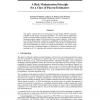Free Online Productivity Tools
i2Speak
i2Symbol
i2OCR
iTex2Img
iWeb2Print
iWeb2Shot
i2Type
iPdf2Split
iPdf2Merge
i2Bopomofo
i2Arabic
i2Style
i2Image
i2PDF
iLatex2Rtf
Sci2ools
NIPS
2007
2007
A Risk Minimization Principle for a Class of Parzen Estimators
This paper1 explores the use of a Maximal Average Margin (MAM) optimality principle for the design of learning algorithms. It is shown that the application of this risk minimization principle results in a class of (computationally) simple learning machines similar to the classical Parzen window classifier. A direct relation with the Rademacher complexities is established, as such facilitating analysis and providing a notion of certainty of prediction. This analysis is related to Support Vector Machines by means of a margin transformation. The power of the MAM principle is illustrated further by application to ordinal regression tasks, resulting in an O(n) algorithm able to process large datasets in reasonable time.
Information Technology | Maximal Average Margin | NIPS 2007 | Optimality Principle | Risk Minimization Principle |
| Added | 30 Oct 2010 |
| Updated | 30 Oct 2010 |
| Type | Conference |
| Year | 2007 |
| Where | NIPS |
| Authors | Kristiaan Pelckmans, Johan A. K. Suykens, Bart De Moor |
Comments (0)

